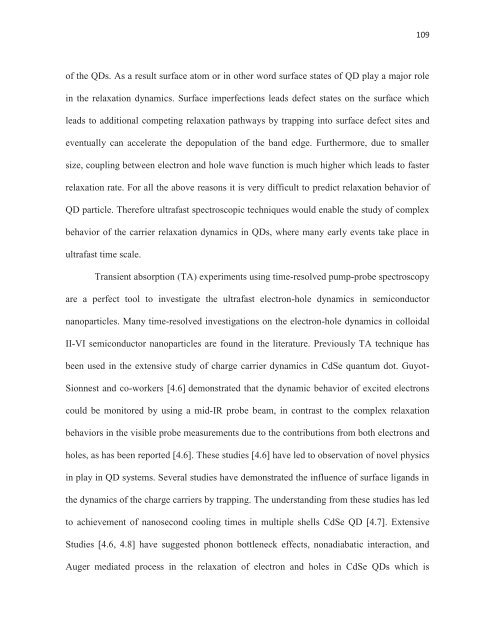CHEM01200604009 Sreejith Kaniyankandy - Homi Bhabha ...
CHEM01200604009 Sreejith Kaniyankandy - Homi Bhabha ...
CHEM01200604009 Sreejith Kaniyankandy - Homi Bhabha ...
Create successful ePaper yourself
Turn your PDF publications into a flip-book with our unique Google optimized e-Paper software.
109<br />
of the QDs. As a result surface atom or in other word surface states of QD play a major role<br />
in the relaxation dynamics. Surface imperfections leads defect states on the surface which<br />
leads to additional competing relaxation pathways by trapping into surface defect sites and<br />
eventually can accelerate the depopulation of the band edge. Furthermore, due to smaller<br />
size, coupling between electron and hole wave function is much higher which leads to faster<br />
relaxation rate. For all the above reasons it is very difficult to predict relaxation behavior of<br />
QD particle. Therefore ultrafast spectroscopic techniques would enable the study of complex<br />
behavior of the carrier relaxation dynamics in QDs, where many early events take place in<br />
ultrafast time scale.<br />
Transient absorption (TA) experiments using time-resolved pump-probe spectroscopy<br />
are a perfect tool to investigate the ultrafast electron-hole dynamics in semiconductor<br />
nanoparticles. Many time-resolved investigations on the electron-hole dynamics in colloidal<br />
II-VI semiconductor nanoparticles are found in the literature. Previously TA technique has<br />
been used in the extensive study of charge carrier dynamics in CdSe quantum dot. Guyot-<br />
Sionnest and co-workers [4.6] demonstrated that the dynamic behavior of excited electrons<br />
could be monitored by using a mid-IR probe beam, in contrast to the complex relaxation<br />
behaviors in the visible probe measurements due to the contributions from both electrons and<br />
holes, as has been reported [4.6]. These studies [4.6] have led to observation of novel physics<br />
in play in QD systems. Several studies have demonstrated the influence of surface ligands in<br />
the dynamics of the charge carriers by trapping. The understanding from these studies has led<br />
to achievement of nanosecond cooling times in multiple shells CdSe QD [4.7]. Extensive<br />
Studies [4.6, 4.8] have suggested phonon bottleneck effects, nonadiabatic interaction, and<br />
Auger mediated process in the relaxation of electron and holes in CdSe QDs which is
















